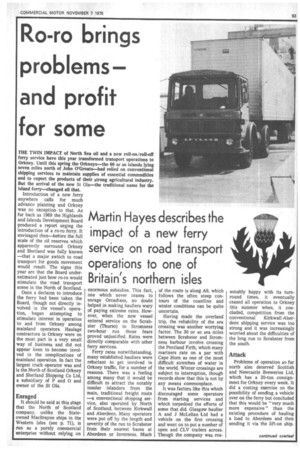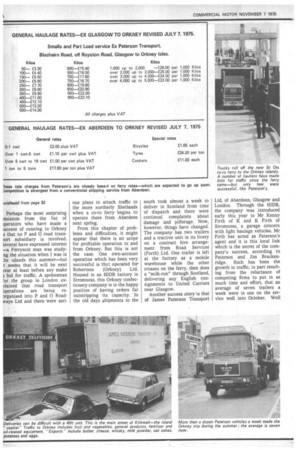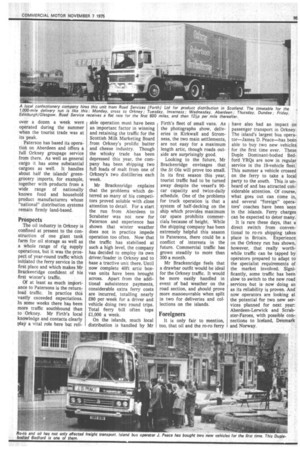Martin Hayes describes the impact of a new ferry service on road transport operations to one of Britain's northern isles
Page 95

Page 96

Page 97

If you've noticed an error in this article please click here to report it so we can fix it.
THE TWIN IMPACT of North Sea oil and a new roll-on/roll-off ferry service have this year transformed transport operations to Orkney. Until this spring the Orkneys—the 60 or so islands lying seven miles north of John O'Groats—had relied on conventional shipping services to maintain supplies of essential commodities and to export the products of their strong agricultural industry. But the arrival of the new St Ola—the traditional name for the Island ferry—changed all that.
Introduction of a new ferry anywhere calls for much advance planning and Orkney was no exception to that. As far back as 1969 the Highlands and Islands Development Board produced a report urging the introduction of a ro-ro ferry. It envisaged then—before the full scale of the oil reserves which apparently surround Orkney and Shetland was fully known —that a major switch to road transport for goods movement would result. The signs this year are that the Board underestimated just how ro-ro would stimulate the road transport scene in the North of Scotland.
Once a dedision to introduce the ferry had been taken the Board, though not directly involved in the vessel's operation, began attempting to stimulate interest in operation to and from Orkney among mainland operators. Haulage contractors in Orkney were on the most part in a very small way of business and did not appear keen to become involved in the complications of mainland operation. In fact The largest truck operator was and is the North of Scotland Orkney and Shetland Shipping Co Ltd, a subsidiary of P and 0 and owner of the St Ola.
Enraged
It should be said at this stage that the North of Scotland company, unlike the Stateowned MacBrayne ships in the Western Isles (see p. 71), is run as a purely commercial enterprise without •relying on enormous subsidies. This fact, one which never ceases to enrage Orcadians, no doubt helped in making hauliers wary of paying extreme rates. However, when the new vessel entered service on the Scrabster (Thurso) to Stromness two-hour run those fears proved unjustified. Rates were directly comparable with other ferry services.
Ferry rates notwithstanding, many established hauliers were reluctant to get involved in Orkney traffic, for a number of reasons. There was a feeling among many that it would be difficult to attract the notably insular islanders from the main, traditional freight route —a conventional Shipping service, also operated by North of Scotland, 'between Kirkwall and Aberdeen. Many operators were put off by the length and severity of the run to Scrabster from their nearest bases at Aberdeen or Inverness. Much of the route is along A9, which follows the often steep contours of the coastline and winter conditions can be quite uncertain.
Having made the overland trip, the reliability of the sea crossing was another worrying factor. The 30 or so sea miles between Scrabster and Stromness harbour involve crossing the Pentland Firth, which many mariners rate on a par with Cape Horn as one of the most difficult stretthes of water in the world. Winter crossings are subject to interruption, though records show that this is not by any means commonplace.
It was factors like this which discouraged some operators from starting services and which torpedoed the efforts of some that did. Glasgow haulier A and J McLellan Ltd had a vehicle on •the first crossing and went on to put a number of open and CLV trailers across. Though the company was rea sonably happy with its turnround times, it eventually ceased all operation to Orkney this summer when, it concluded, competition from the conventional Kirkwall-Aberdeen shipping service was too strong and it was increasingly worried about the difficulties of the long run to Scrabster from the south.
Attack
Problems of operation so far north also deterred Scottish and Newcastle Breweries Ltd, which has a 20-ton consignment for Orkney every week. It did a costing exercise on the possibility of sending a vehicle over on the ferry but concluded that this would be " very much more expensive" than the existing procedure of hauling a load to Aberdeen and then sending it via the lift-on ship.
Perhaps the most surprising mission from the list of verators who have made a mccess of running to Orkney s that no P and 0 road transiort subsidiary is involved. ieveral have expressed interest —a Ferryscot man was studyng the situation when I was in ;he islands this summer—but t seems that it will be next rear at least before any make i bid for traffic. A spokesman or the group in London exDlained that road transport Dperations are being reDrganised into P and 0 Roadways Ltd and there were seri ous plans to attack traffic to the more northerly Shetlands when a ro-ro ferry begins to operate there from Aberdeen next spring.
From this chapter of problems and difficulties, it might appear that there is no scope for profitable operation to and from Orkney. But this is not the case. One own-account operation which has been very successful is that operated for Robertson (Orkney) Ltd. Housed in an HIDB factory in Stromness, this Orkney confectionery company is in the happy position of having orders far outstripping its capacity. In the old days shipments to the south took almost a week to deliver in Scotland from time of dispatch and there were continual complaints about damage and pilferage. Now, however, things have changed. The company has two trailers and a tractive unit in its livery on a contract hire arrangement from Road Services (Forth) Ltd. One trailer is left at the factory as a mobile warehouse while the other crosses on the ferry, then does a "milk-run" through Scotland, delivering any English consignments to United Carriers near Glasgow.
Another success story is that of James Paterson Transport Ltd, of Aberdeen, Glasgow and London. Through the HIDB, the company was introduced early this year to Mr Kenny Firth of K and K Firth of Stromness, a garage concern with light haulage vehicles. Mr Firth has acted as Paterson's agent and it is this local link which is the secret of the company's success, according to Paterson and Jim Brackenridge. Such has been the growth in traffic, in part resulting from the reluctance of competing firms to put in as much time and effort, that an average of seven trailers a week were in use on the service well into October. Well over a dozen a week were operated during the summer When the tourist trade was at its peak.
Paterson has based its operation on Aberdeen and offers a full Orkney groupage service from there. As well as general cargo it has some substantial cargoes as well. It handles about half the islands' greengrocery imports, for example, together with products from a wide range of nationally known food and household product manufacturers whose "national" distribution systems remain firmly land-based.
Prospects
The oil industry in Orkney is confined at present to the construction of one giant tank farm for oil storage as well as a whole range of rig supply operations, but it was the prospect of year-round traffic which initiated the ferry service in the first place and which makes Mr Brackenridge confident of his first winter's traffic.
Of at least as much importance to Patersons is the return: load traffic. In practice this vastly exceeded expectations. In some weeks there has been more traffic southbound than to Orkney. Mr Firth's local knowledge and contacts clearly play a vital role here but reli able operation must have been an important factor in winning and retaining the traffic for the Scottish Milk Marketing Board from Orkney's prolific butter and cheese industry. Though the whisky trade has been depressed this year, the company has been shipping two full toads of malt from one of Orkney's two distilleries each week.
Mr Brackenridge explains that the problems which deterred so many of his competitors proved soluble with close attention to detail. For a start the run from Aberdeen to Scrabster was not new for Paterson and experience has shown that winter weather does not in practice impede operation too often. Now that the traffic has stabilised at such a high level, the company has decided to employ its own driver/loader in Orkney and to base a tractive unit there. Until now complete 40ft artic boxvan units have been brought across. Apart from the additional subsistence payments, considerable extra ferry costs are incurred, totalling nearly £80 per week for a driver and vehicle doing two round trips. Total ferry bill often tops £1,000 a week.
On the islands, much local distribution is 'handled by Mr Firth's fleet of small vans. As the photographs show, deliveries in Kirkwall and Stromness, the two main settlements, are not easy for a maximum length artic, though roads outside are surprisingly good.
Looking to the future, Mr Brackenridge envisages that the St Oia will prove too small. In its 'first season this year, tourist traffic had to be turned away despite the vessel's 90car capacity and twice-daily schedule. One of the prOblerns for truck operation is that a system of half-decking on the ship which provides maximum car space prohibits commercials because of height. While the shipping company has been extremely helpful this season to Patersons, there could be a conflict of interests in •the future. Commercial traffic has grown steadily to more than 300 a month.
Mr Brackenridge feels that a drawbar outfit would be ideal for the Orkney traffic. It would be more easily handled in event of bad weather on the road section, and should prove more manoeuvrable when sprit in two for deliveries and col. lections on the islands.
Foreigners
It is only fair to mention, too, that oil and the ro-ro ferry have also had an impact on passenger transport in Orkney. The island's largest bus operator—James D. Peace—has been able to buy two new vehicles for the first time ever. These Duple Dominant-bodied Bedford YRQs are now in regular service in the 19-vehicle fleet. This summer a vehicle crossed on the ferry to take a local party to the south. This is unheard of and has attracted considerable attention. Of course, what goes out can come in, and several "foreign" operators' coaches have been seen in the islands. Ferry charges can be expected to deter many.
It is rare these days, that a direct switch from conventional to ro-ro shipping takes place in Britain. Experience on the Orkney run has shown, however, that really worthwhile traffic can be tapped by operators prepared to adapt to the specialist requirements of the market involved. Significantly, some traffic has been slow to switch to the new road serVices but isnow doing so as its reliability is proven. And now operators are looking at the potential for two new services planned for next year: Aberdeen-Lerwick and Scrabster-Faroes, with possible connections to Iceland, Denmark and Norway.
















































































































































































































